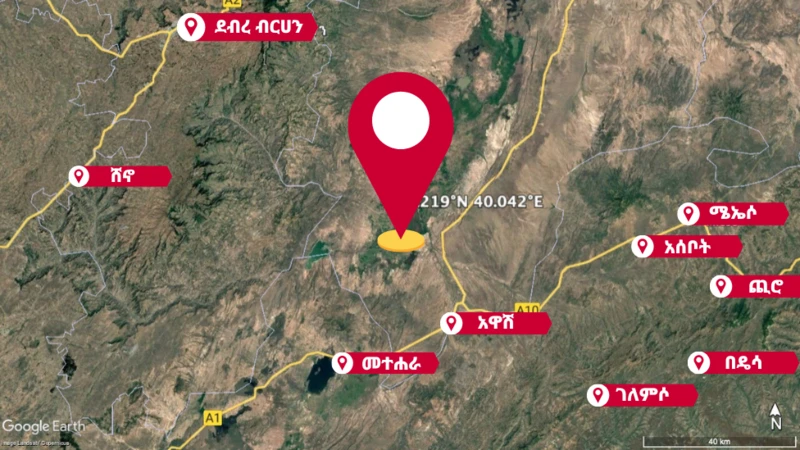Understanding the Causes of Earthquakes in Ethiopia
Ethiopia, a country rich in history and culture, is also home to one of the most dynamic and active geological landscapes in the world. Earthquakes, while not daily occurrences, are a notable part of life in this region. But what exactly causes these seismic events in Ethiopia? Let’s dive into the science behind it.
 |
| Google Earth Pro |
The Role of the East African Rift System (EARS)
At the heart of Ethiopia's seismic activity lies the East African Rift System (EARS), a massive tectonic feature that spans thousands of kilometers. This rift is where the African continent is slowly splitting into two plates: the Nubian Plate to the west and the Somali Plate to the east.
As these plates move apart, the Earth's crust stretches, thins, and fractures along fault lines. This stretching leads to earthquakes as the crust adjusts to the tectonic forces. Ethiopia is particularly impacted because it sits right at the intersection of the rift and two other tectonic features, the Red Sea Rift and the Gulf of Aden Rift, forming the geologically significant Afar Triple Junction.
Volcanic Activity: A Major Contributor
Ethiopia is home to some of the most active volcanoes in the world, particularly in the Afar region. The movement of magma beneath these volcanoes often triggers earthquakes. For example:
- Erta Ale Volcano: Known for its persistent lava lake, seismic activity here is tied to magmatic movements.
- Dabbahu Volcano: In 2005, a series of earthquakes preceded a major volcanic eruption, highlighting the connection between these two phenomena.
Volcanic eruptions don’t just reshape the landscape; they also alter stress within the Earth’s crust, leading to further seismic events.
Geophysical Processes at Play
Crustal Extension
The process of rifting causes the Earth’s crust to stretch and thin. Over time, the crust fractures to release the accumulated stress, resulting in earthquakes.
Isostatic Adjustments
As the Ethiopian Plateau and surrounding regions adjust to changes in the Earth's gravitational balance, minor earthquakes can occur. This process, though gradual, is a natural part of the Earth's geophysical cycle.
Thermal Anomalies
Beneath Ethiopia, the mantle is unusually hot due to the rift system. This heat contributes to crustal expansion, fracturing, and seismic activity.
Human Factors: Are We Contributing?
While natural processes dominate, human activities also play a small role:
- Reservoir-Induced Seismicity: Large reservoirs, such as the Grand Ethiopian Renaissance Dam (GERD), can put immense pressure on the Earth's crust, potentially triggering minor earthquakes.
- Geothermal Energy Projects: Drilling for geothermal energy can occasionally induce seismic events, though these are typically low in magnitude.
Recent Earthquakes in Ethiopia
Ethiopia has seen notable seismic events in recent years:
- Dabbahu Earthquake Sequence (2005): A series of earthquakes associated with volcanic activity and crustal rifting.
- Afar Region (2024–2025): Moderate earthquakes, ranging from 4.8 to 5.8 in magnitude, have been linked to rifting and magmatic processes.
These events emphasize the active nature of Ethiopia’s geology and the importance of preparedness.
The Human Impact
Earthquakes don’t just rattle the ground; they also affect lives:
- Infrastructure Vulnerability: Many buildings in Ethiopia are not designed to withstand seismic activity, making even moderate earthquakes potentially destructive.
- Preparedness: Ethiopia is making strides in seismic monitoring, with networks designed to provide early warnings and inform disaster response plans.
Why Understanding Matters
Understanding the causes of earthquakes in Ethiopia is crucial for several reasons:
- Risk Mitigation: Better knowledge leads to improved infrastructure and disaster response.
- Scientific Insight: Ethiopia provides a unique window into the processes driving continental rifting, contributing to global geological research.
- Community Safety: Awareness and education help communities prepare for and respond to seismic events.
Conclusion: A Land in Motion
Ethiopia’s position along the East African Rift makes it a land of incredible geological dynamism. The interplay of tectonic movements, volcanic activity, and human influence creates a complex seismic environment. While earthquakes are a natural part of this landscape, continued research and monitoring are vital for understanding and mitigating their impact.
Ethiopia’s seismic activity is a reminder of the Earth’s ever-changing nature. As the African continent slowly transforms, Ethiopia stands at the forefront of this fascinating geological journey.

Comments
Post a Comment